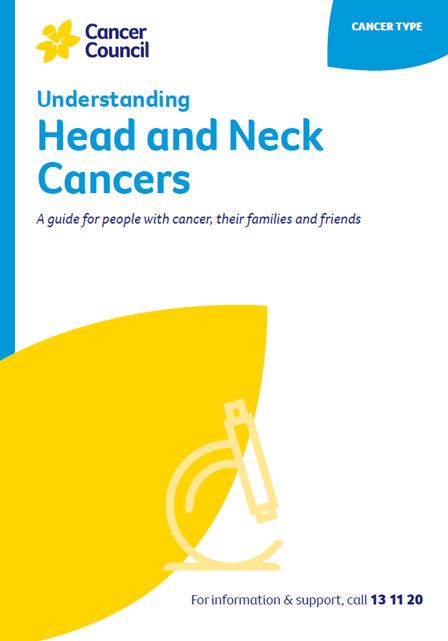- Home
- Head and neck cancers
- Managing side effects
- Breathing changes
Breathing changes
Some people treated for head and neck cancer need a tracheostomy. This is an alternative airway created in the front of the neck so they can keep breathing freely.
Learn more about:
- Having a tracheostomy
- Having a laryngectomy
- Living with a tracheostomy or stoma
- Speaking after a laryngectomy
Having a tracheostomy
If you have a tracheostomy, a small cut in the lower neck allows a tube to be inserted into the windpipe. This can be used for breathing during and after surgery when the mouth or throat becomes swollen. It will also make it easier for you to cough up mucus after a long operation. The tube is usually removed within one week of surgery once the swelling has gone down. In some cases, a tracheostomy is needed for longer than this. It is sometimes needed during radiation therapy, though this is uncommon.
The thought of a tracheostomy may be confronting and scary – talk to your treatment team about how you are feeling and ask them to explain why the tracheostomy is needed. Initially you may not be able to speak, but you will be supported by your treatment team while you have a tracheostomy in place. The speech pathologist and physiotherapist will play an important role in your care.
Once the tracheostomy tube is removed, the hole in your neck normally closes within days. During this time, your voice may be weak and breathy, returning to normal when the hole closes.
Tracheostomy
A tracheostomy is a surgically created hole (stoma) in your windpipe (trachea) that provides another airway for breathing. A tracheostomy tube is inserted through the hole, and it m y be temporary or permanent.

Having a laryngectomy
If you have a total laryngectomy, a permanent stoma or breathing hole will be created in your lower neck at the time of the surgery. This will be discussed with you before surgery so you know exactly what to expect, including how you will speak again. If you need a permanent stoma, the speech pathologist and nurses will teach you how to look after it.
Laryngectomy stoma
A laryngectomy stoma is a permanent opening in your neck that allows you to breathe. It does not require a tube to keep it open, but some people have a laryngectomy tube to stop the hole getting smaller.

Living with a tracheostomy or stoma
Having a tracheostomy or stoma is a big change and takes some getting used to. Your specialist, nurse, physiotherapist or speech pathologist can explain ways to manage the following concerns:
| caring for the tube or stoma | you will be shown how to clean and care for the tracheostomy tube or stoma. |
| coping with dry air | the air you breathe will be much drier since it no longer passes through your nose and mouth, which normally moistens and warms the air. This can cause irritation, coughing and extra mucus coming out of the tracheostomy tube or stoma. There are products available that cover the stoma or attach to the tracheostomy tube to provide heat and moisture for the windpipe. Your treating team will recommend which option is best for you. |
| swimming and bathing | you will need to use a special stoma cover to avoid water getting into the windpipe, even in the shower. If you have a laryngectomy stoma, you may not be able to go swimming. |
Speaking after a laryngectomy
If the larynx (voice box) is removed, there are various ways to speak.
Voice prosthesis speech – The surgeon makes an opening between your trachea and oesophagus. This is called a tracheoesophageal fistula or puncture. A small voice prosthesis (or valve) is inserted to direct air from your trachea to the oesophagus. This will allow you to speak clearly in a low-pitched, throaty voice.
Mechanical speech – A battery- powered device (electrolarynx) is used to create a mechanical voice. The device is held against the neck or cheek or placed inside the mouth. You press a button on the device to make a vibrating sound.
Oesophageal speech – You swallow air and force it up through your oesophagus to produce a low- pitched sound. This method can be difficult, and you will need training.
→ READ MORE: Pain, numbness and stiffness
Podcast for people affected by cancer
Listen now
More resources
A/Prof Martin Batstone, Oral and Maxillofacial Surgeon and Director of the Maxillofacial Unit, Royal Brisbane and Women’s Hospital, QLD; Polly Baldwin, 13 11 20 Consultant, Cancer Council SA; Martin Boyle, Consumer; Dr Teresa Brown, Assistant Director Dietetics, Royal Brisbane and Women’s Hospital, Honorary Associate Professor, University of Queensland, QLD; Dr Hayley Dixon, Head, Clinical Support Dentistry Department, WSLHD Oral Health Services, Public Health Dentistry Specialist, NSW; Head and Neck Cancer Care Nursing Team, Royal Melbourne Hospital, VIC; Rhys Hughes, Senior Speech Pathologist, Peter MacCallum Cancer Centre, VIC; Dr Annette Lim, Medical Oncologist and Clinician Researcher – Head and Neck and Non-melanoma Skin Cancer, Peter MacCallum Cancer Centre, VIC; Dr Sweet Ping Ng, Radiation Oncologist, Austin Health, VIC; Deb Pickersgill, Senior Clinical Exercise Physiologist, Queensland Sports Medicine Centre, QLD; John Spurr, Consumer; Kate Woodhead, Physiotherapist, St Vincent’s Health, Melbourne, VIC; A/Prof Sue-Ching Yeoh, Oral Medicine Specialist, University of Sydney, Sydney Oral Medicine, Royal Prince Alfred Hospital, Chris O’Brien Lifehouse, NSW.
View the Cancer Council NSW editorial policy.
View all publications or call 13 11 20 for free printed copies.

